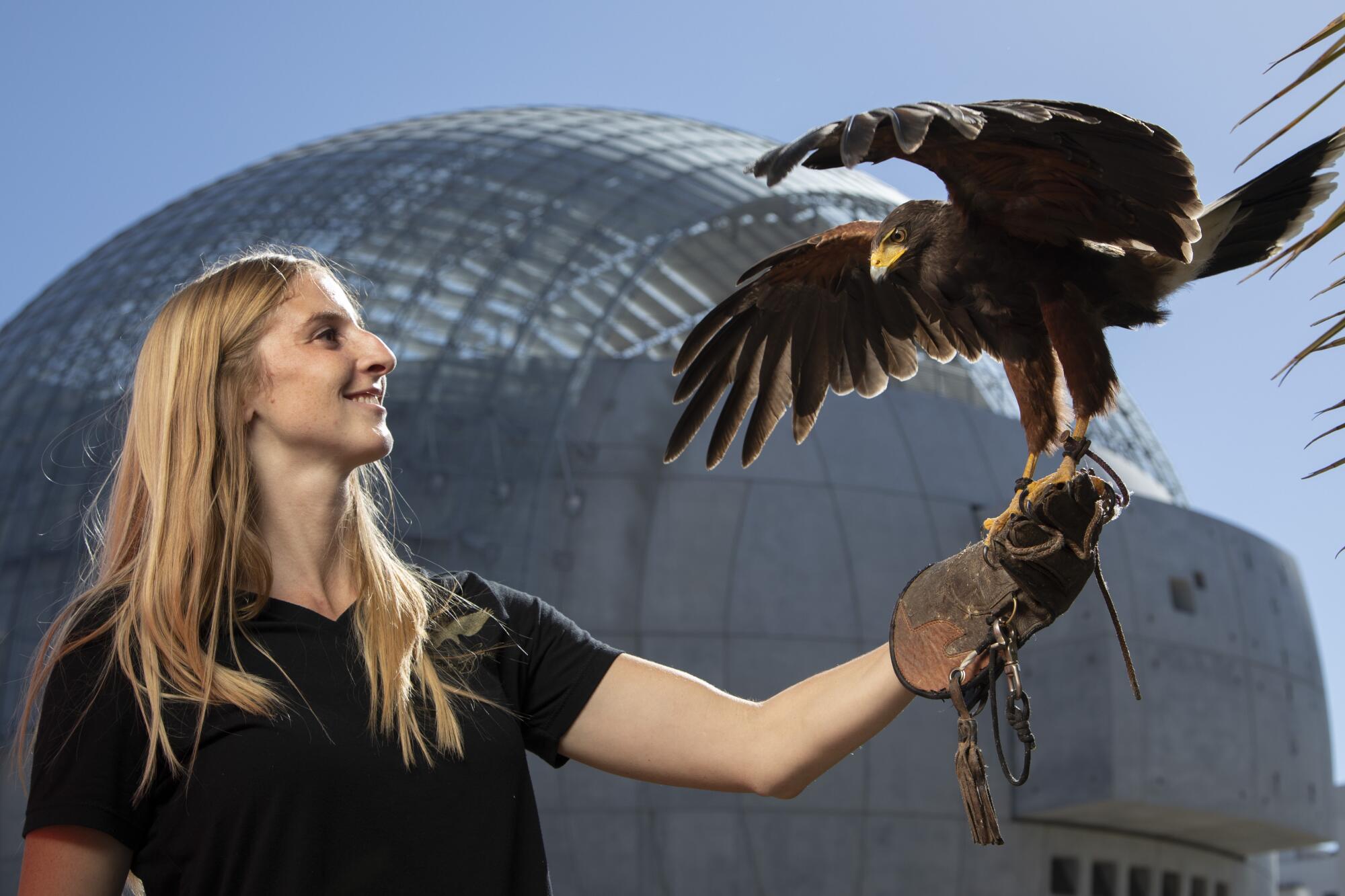
- Share via
A co-worker describes Spencer as “a real go-getter.”
Today is Spencer’s day off, however, so he’s a bit more chill than usual. His belly is full of raw quail meat and he’s feeling too heavy to work. But he’s agreed, nonetheless, to leave the comfort of his Palmdale aviary where he lives with his brother, Shady, to meet The Times for an interview on the plaza of the new Academy Museum of Motion Pictures.
Spencer is a trained Harris’ hawk, and his job is to fly above the museum and its gleaming glass dome to ward off pigeons that could nest inside the open-air terrace or mar the new landmark with poop. His efforts are appreciated now more than ever, as the Academy Museum readies to open on Sept. 30. The museum has just undergone an intensive, five-week building cleaning, with all 1,500 glass panels on its dome scrubbed for the premiere.

Today, Spencer has brought along his trainer, Lindsey Benger. Falconry-based bird abatement, she says, is a “natural, non-toxic form of pest management.” It’s more humane than setting out poisons and spikes on surfaces, and it’s more effective than hanging streamers or fake owls to scare off birds.
Benger, a falconer for almost 12 years, is a subcontractor through the Hawk Proz, which provides falconry services throughout the western U.S. The company has a contract with the Academy Museum to fly Spencer eight times a month, twice a week on average, for up to two hours each outing. When he started in 2017, Spencer visited three or four times a week because the pigeon problem was more serious.
As Benger explains this, Spencer sits upright on her gloved wrist, anklets attached to a leash on his lower legs and a leather hood over his head to keep him calm. His pointy yellow and black beak jerks left to right as he takes in the conversation.
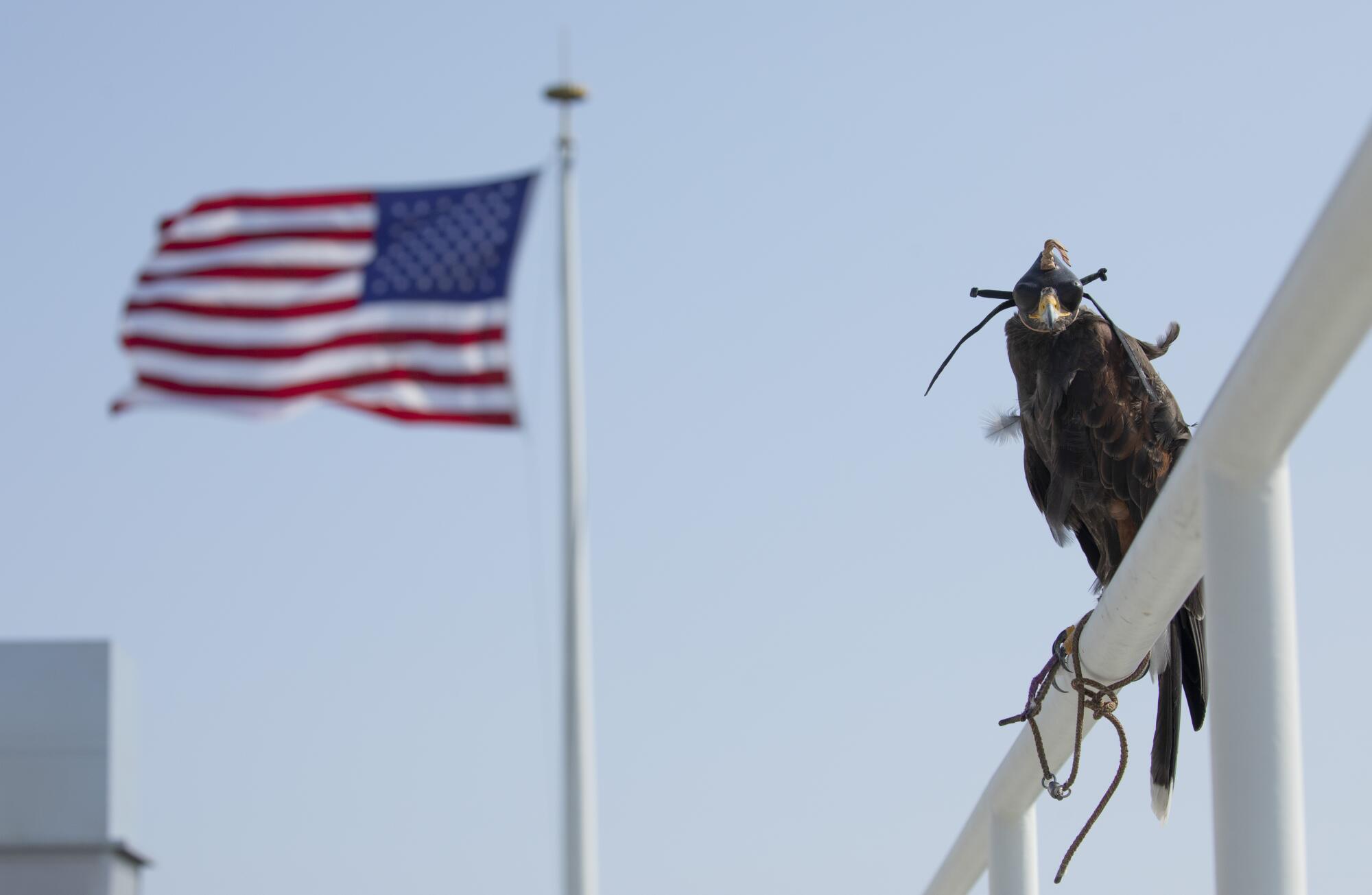
The practice of falconry-based bird abatement is not uncommon in places such as vineyards, where a flock of blackbirds can wipe out a harvest of grapes in a week, and landfills, which are brimming with trash that’s enticing to seagulls. But over the past decade, it’s become a growing practice in more densely commercial areas, such as malls and office buildings.
And, apparently, museums.
Another of Spencer’s gigs? Flying over the Los Angeles County Museum of Art, next door to the Academy Museum — a job he’s held since 2017 — in order to keep pigeons and seagulls away from the museum’s outdoor eating areas.
“LACMA used to have a big problem,” Benger says. “The seagulls would drag trash up to the roof and pick at the roof itself, pulling material off, and pigeons would go under the canopies. But this was years ago — another hawk was at LACMA before Spencer. It’s under control now.”
The Academy Museum, meanwhile, had developed a problem with pigeons even as it was under construction. In 2017 pigeons were roosting inside its Saban Building — the former 1939 May Co. building — while it was undergoing a major renovation. They were leaving splotches of excrement, feather dander and regurgitated food on structural beams and construction equipment. Eventually, they took over a western-facing ledge on the exterior of the building. Someone had been leaving birdseed in the 99 Cents Only Store parking lot across the street, and the Saban ledge provided cafeteria seating with a view.
The pigeons were flying over the glass dome construction at the time but hadn’t yet roosted inside the structure when Spencer arrived. “Eventually, it would have been a problem,” Benger says.
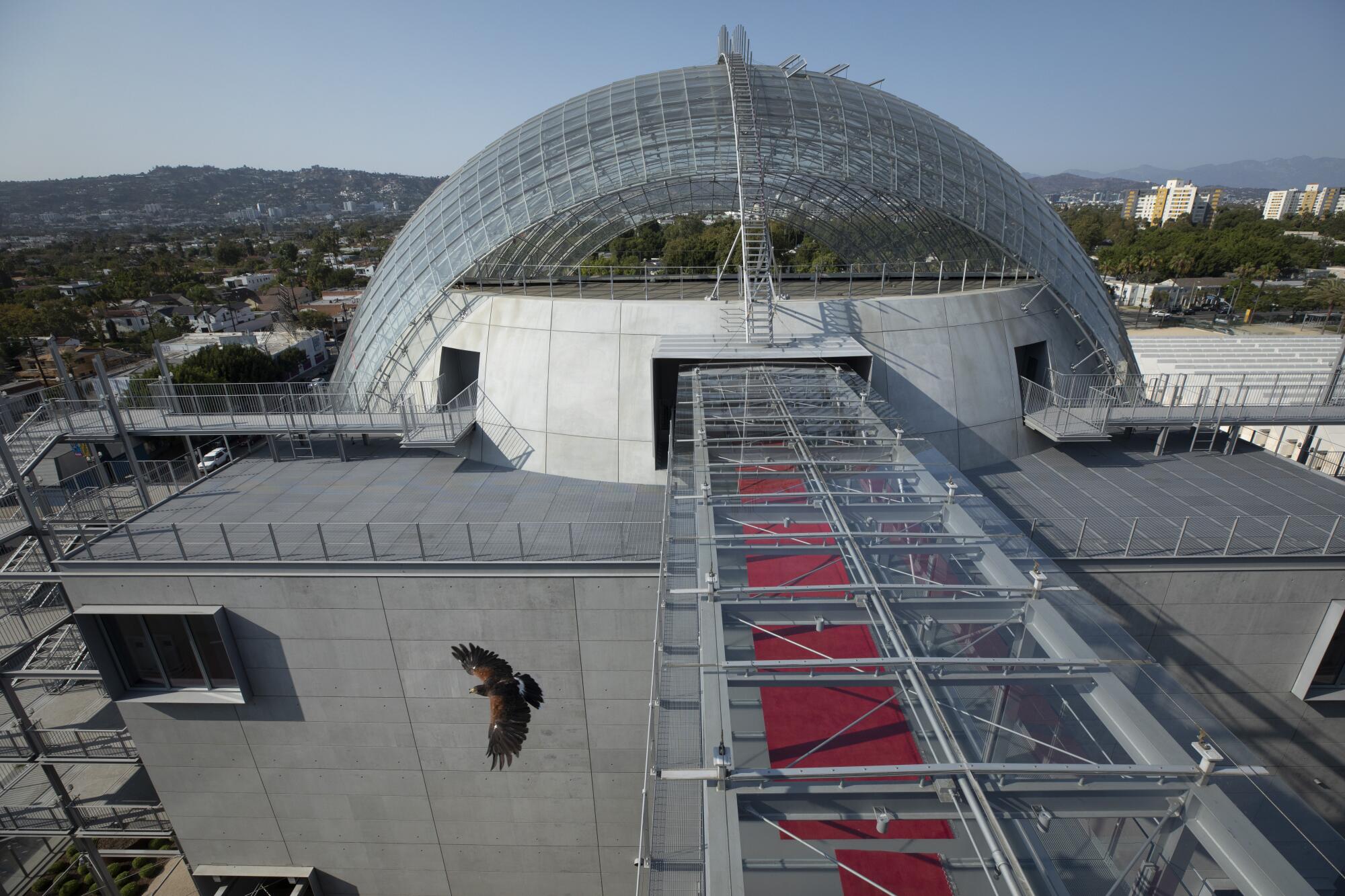
The Academy Museum of Motion Pictures has opened as the ultimate celebration of Hollywood history, Oscar lore and today’s movie makers.
Spencer — 4 years old, slender and known to be an enthusiastic chaser of pigeons — was perfect for the Academy Museum job. Sure, he could be a a prima donna, even sassy or cranky, occasionally squawking at Benger and flat-out refusing to work some mornings. (Shady takes his place those days.) But he’s also fast, with strong legs and sharp eyesight, skilled at finding dark nooks where pigeons hide, then swooping down and catching them by surprise and sending them off in a panicked flutter.
In HR parlance, Spencer would be considered “proactive” on pigeon projects. So the Academy Museum job landed in his feathered lap.
Spencer’s services run from $150 to $325 per visit, depending on the size of the property and the intensity of the problem, among other factors. Benger is the only human he trusts enough to fly for. She mixes up their exact days and arrival times so as to be unpredictable.
“I’ve found that if I come at the same time every day, the pigeons will learn that and they’ll start coming at a different time,” Benger says.
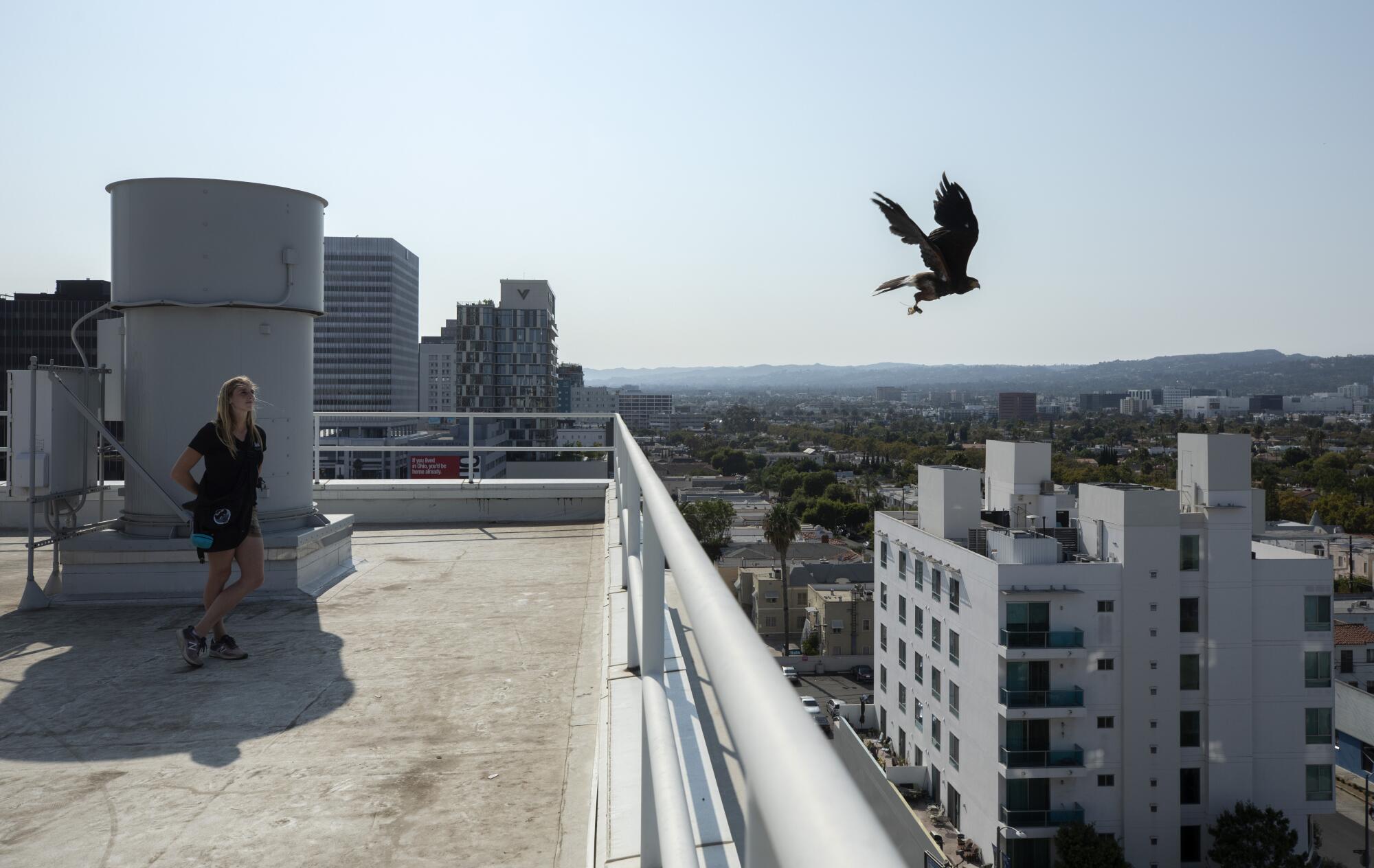
Spencer takes off from the roof of the Saban Building wearing a GPS backpack that Benger tracks on her phone so she always knows where he is. Which is typically “playing in the wind” about 100 to 150 feet from the ground, making large circles over the Academy Museum property or LACMA’s campus. When it’s time to call him back, Benger simply raises her glove in the air and Spencer circles back and lands on it.
He doesn’t fly away for good, Benger says, because “he knows it’s easier to get food from me than on his own.”
But Spencer has gone rogue at times, taking off on “exploratory flights,” as Benger calls them, to a nearby park while chasing his prey. In those instances, Benger simply tracks him down in her blue Subaru, and Spencer always returns to her outstretched, gloved hand.
Pigeons are surprisingly smart, Benger says. It took just one month for the birds nesting inside the Saban Building to learn that there was a new boss in the air space, and they cleared out. Breaking their habit of sitting on the exterior ledge took longer, about three to four months. “Because we can’t catch them by surprise [there] as much as when they’re in an enclosed space,” Benger says, adding that the birdseed across the street compounded the problem.
Benger chalks up Spencer’s success to his unbridled passion for pigeons.
“If a hawk is really pursuing them — dodging and chasing like Spencer — they’ll know, ‘OK, that hawk is serious. We don’t want to mess with that hawk.’”
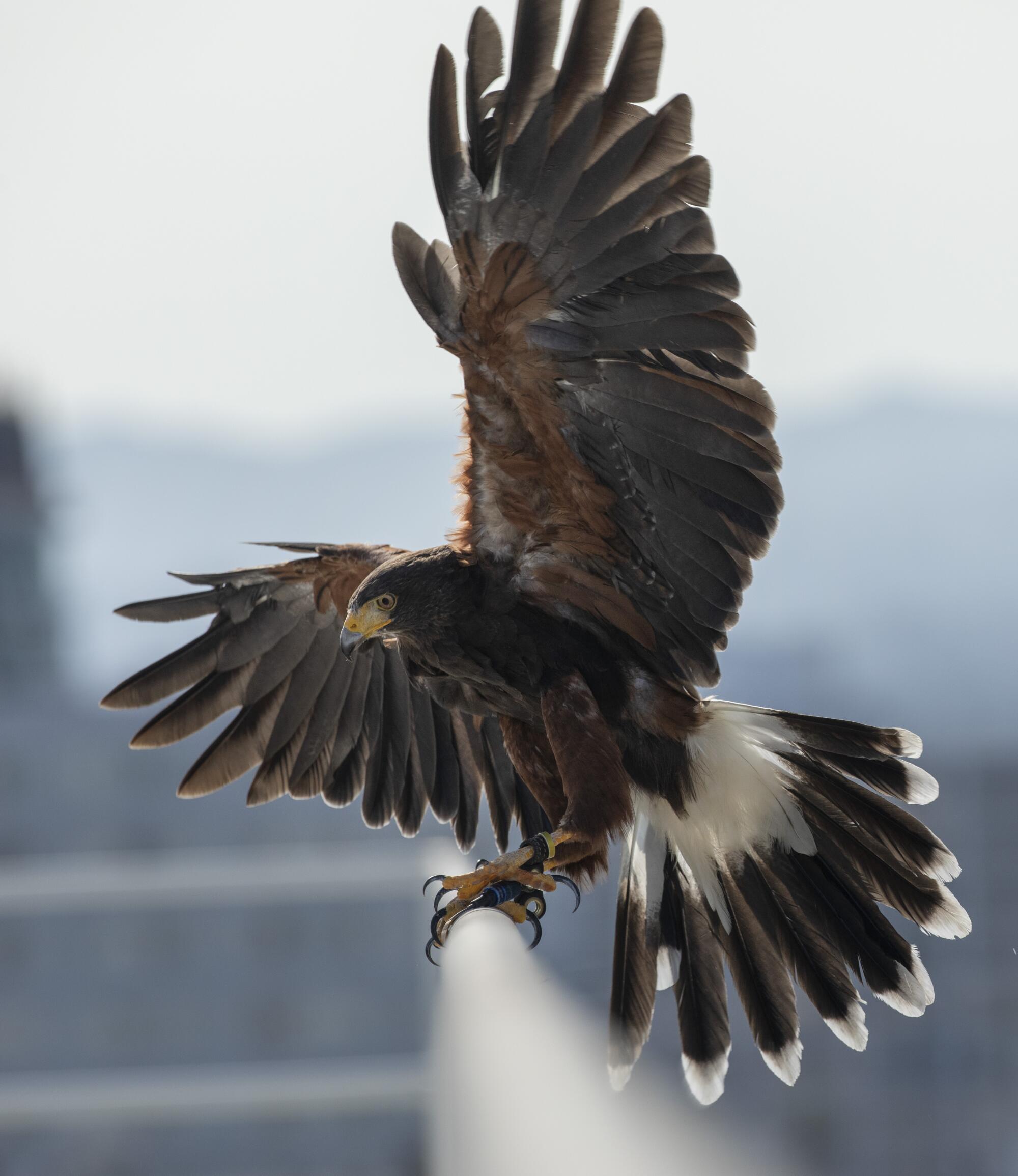
The early days of the pandemic were a setback for Spencer, however. Because the museum building was closed, Benger couldn’t access its rooftop so Spencer took flight from the ground. From such a low vantage point, where flying upwards and fighting gravity slowed him down, Spencer wasn’t able to surprise the pigeons, as he would have from above.
“The pigeons came back and we had to re-establish Spencer’s presence,” Benger says.
Spencer thinks of the pigeons as food, but he rarely, if ever, catches a bird. It’s happened only once in the four years he’s been working with Benger, and in that instance, she was able to entice him, with food, to drop the bird from his claws. “We’re typically just scaring them away,” Benger says.
The job is actually far more dangerous for Spencer than it is for the pigeons.
“Any time we fly a bird free, they’re going to be exposed to the same dangers that wild hawks are exposed to — and there are a lot of them,” Benger says.
Electrocution from power lines is a hazard, as are cars and windows that the hawks might fly into. Already poisoned rats, which the hawks could eat, are a danger. A major threat is being attacked by Peregrine falcons, which nest on a building just up the street. It’s a particular problem in spring, nesting season.
“They get aggressive when their babies are nearby,” Benger says. “They can dive at 250 miles per hour. They’ll circle 1,000 feet up in the sky and if they see your hawk, and if they’re feeling territorial, they’ll dive down. At those speeds, if they hit your hawk, that’s it.”
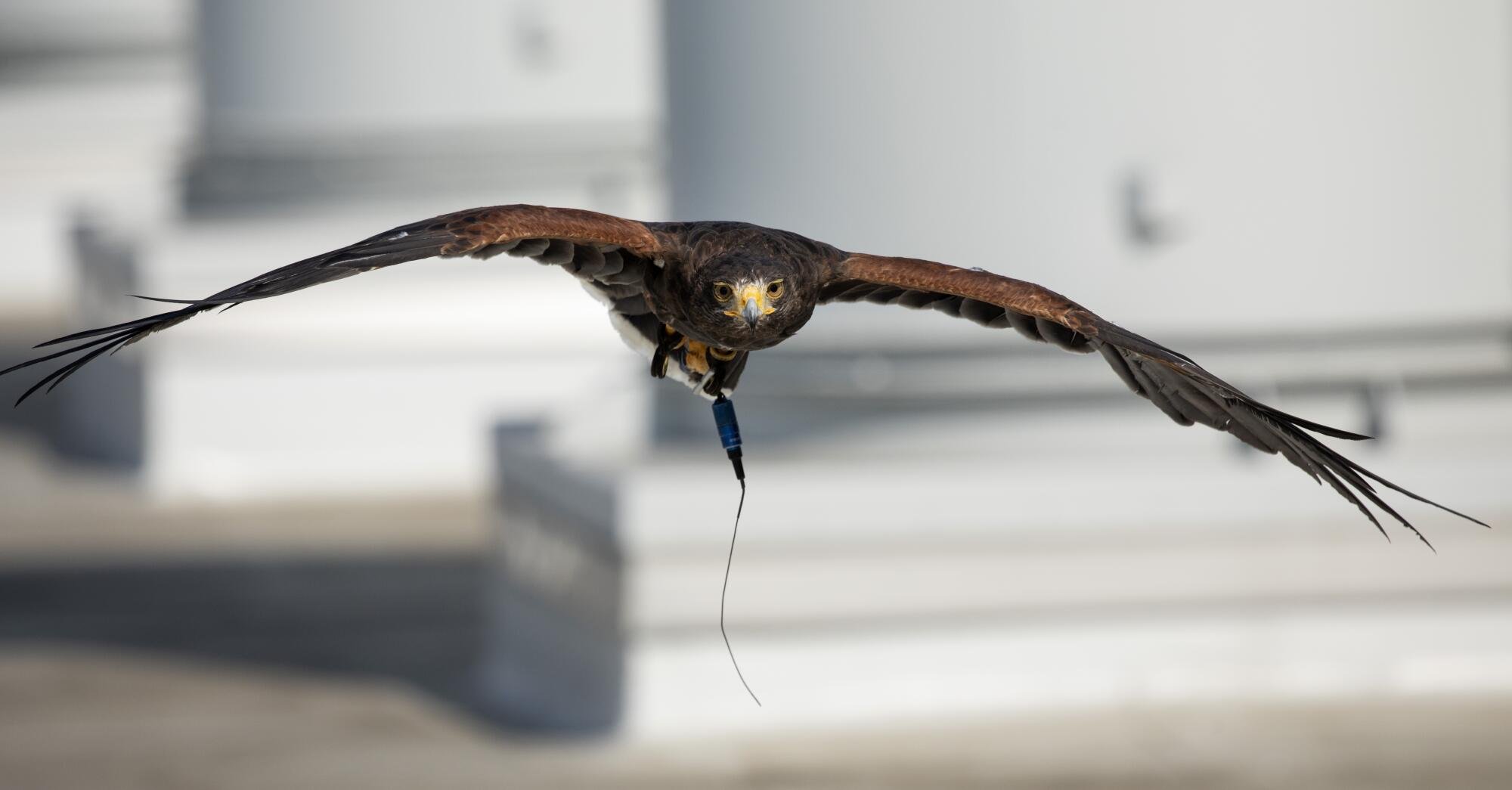
The Academy Museum’s pigeon problem is mostly under control, Benger says. She hasn’t seen a pigeon on the property in two months. Spencer’s job is about maintenance now, as even one or two “regulars” can become a slippery slope.
“You’d be amazed how much poop even just two pigeons can create in a few days,” Benger says. “It can make a big mess. And over time that can stain the stone as well.”
Spencer wouldn’t make a bathroom stop, mid-flight over the museum, Benger says. Hawks “eliminate” before taking off. “It’d be very, very rare,” she says.
Nor would any other bird likely dare mess with the Academy Museum. Spencer has made a lasting impression on the pigeons in the area.
“At this point, we’ve changed their habits,” Benger says. “We came often enough, and made them uncomfortable enough, that they went out and found a new hangout. They don’t feel the need to come here anymore.”
And at that, Spencer cocks his head to the side and lets out a proud caw.
Someone, give this hawk a raise.
How does Renzo Piano’s new Academy Museum rank against other L.A. landmarks like the Hollywood sign and Griffith Observatory?
More to Read
The biggest entertainment stories
Get our big stories about Hollywood, film, television, music, arts, culture and more right in your inbox as soon as they publish.
You may occasionally receive promotional content from the Los Angeles Times.













